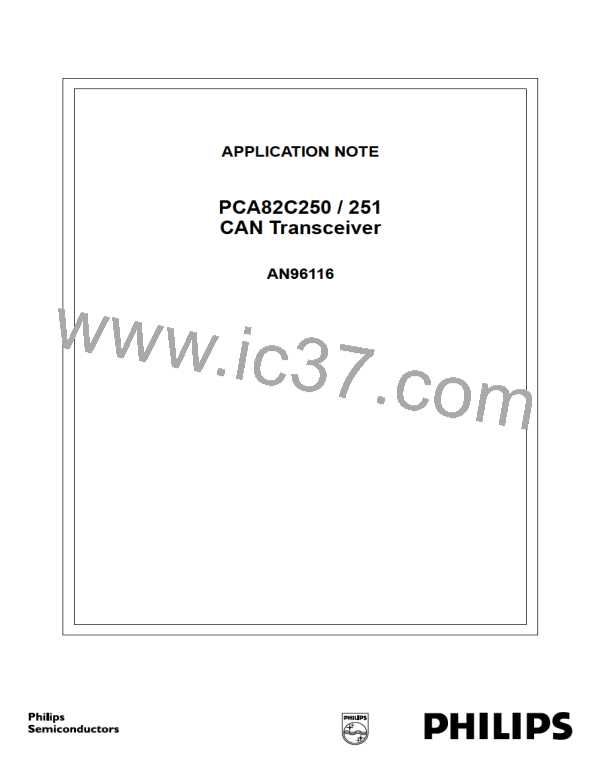Philips Semiconductors
PCA82C250 / 251 CAN Transceiver
Application Note
AN96116
7. CONCLUSION
The PCA82C250 and PCA82C251 are advanced transceiver products being suitable for usage in automotive as
well as general industrial applications with bit rates up to 1 Mbit/s. They support a differential bus signal repre-
sentation as described in the international standard for in-vehicle high-speed applications (ISO 11898) using the
Controller Area Network (CAN) protocol.
Enhanced electromagnetic compatibility (EMC) performance is provided through an extended common-mode
range of -7V to +12V and the slope-control function, where the slew rate of the bus signal can be adjusted via a
resistance value. For battery powered applications a stand-by mode is provided to drastically reduce power con-
sumption of the network, e.g. when a vehicle is parked. In stand-by mode the network is being activated via the
bus lines upon detection of a message.
The PCA82C250 and PCA82C251 are proof against short-circuit conditions on the bus outputs and usual tran-
sients in an automotive environment (ISO 7637). Moreover a thermal shutdown function protects the devices
against thermal overload e.g. due to short-circuit conditions. Both products are designed for connection to the
protocol controller or bus line with a minimum number of external components.
Also both products are capable of driving a large number of bus nodes i.e. 64 to 100 per network, and bus length
of up to about 0.5 to 1 km, which is advantageous primarily in general industrial applications such as the CAN
TM
based system DeviceNet
.
The PCA82C250 and PCA82C251 are pin- and function compatible and operate in a wide supply voltage range
of 5 V ± 10%. For general industrial applications the PCA82C251 should be used because of e.g. its larger drive
capability and higher breakdown voltage protection at the bus outputs.
The advanced functionality being described above makes the PCA82C250 and PCA82C251 an attractive choice
in many automotive and general industrial applications.
8. LIST OF REFERENCES
[1] Data Sheet PCA82C250, Philips Semiconductors, September 1994
[2] Data Sheet PCA82C251, Philips Semiconductors, October 1995
[3] Road vehicles - Interchange of digital information - Controller area network (CAN) for high-speed communi-
cation, ISO 11898, International Standardization Organization, 1993
[4] CAN Bit Timing, Application Note, Philips Semiconductors, 1996 (to be published)
[5] DeviceNet Specification, Volume I, Release 1.3, Open DeviceNet Vendor Association Inc., December 1995
25

 NXP [ NXP ]
NXP [ NXP ]